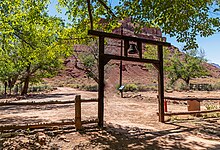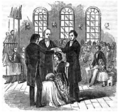|
Welcome to the portal of The Latter Day Saint movement
Introduction The Latter Day Saint movement (also called the LDS movement, LDS restorationist movement, or Smith–Rigdon movement) is the collection of independent church groups that trace their origins to a Christian Restorationist movement founded by Joseph Smith in the late 1820s. Collectively, these churches have over 17 million nominal members, including over 17 million belonging to the Church of Jesus Christ of Latter-day Saints (LDS Church), 250,000 in the Community of Christ, and several other denominations with memberships generally ranging in the thousands of members. The predominant theology of the churches in the movement is Mormonism, which sees itself as restoring again on Earth the early Christian church; their members are most commonly known as Mormons, though the LDS Church now rejects the use of that name. An additional doctrine of the church allows for prophets to receive and publish modern-day revelations. A minority of Latter Day Saint adherents, such as members of Community of Christ, have been influenced by Protestant theologies while maintaining certain distinctive beliefs and practices including continuing revelation, an open canon of scripture and building temples. Other groups include the Remnant Church of Jesus Christ of Latter Day Saints, which supports lineal succession of leadership from Smith's descendants, and the more controversial Fundamentalist Church of Jesus Christ of Latter-Day Saints, which defends the practice of polygamy. (Full article...) General images -The following are images from various Latter Day Saint movement-related articles on Wikipedia.
Selected articleLucinda Lee Dalton (born Lucinda Lee; February 9, 1847 – November 24, 1925) was a Utah teacher, and suffragist. She shared her views through essays and poems published in the Woman's Exponent, a periodical for Latter-day Saint women. Raised by members of the Church of Jesus Christ of Latter-day Saints and devout to the faith, Dalton was a feminist. As a child, she felt jealous of boys for the freedom and privileges they enjoyed and felt that girls were neglected by the education system. She became a women's rights activist, believing that women should have the right to suffrage, education, property, control over their money, and custody of their children. As a teacher, she advocated for equal educational and recreational opportunities for girls. (Full article...)Selected location Lees Ferry (also known as Lee's Ferry, Lee Ferry, Little Colorado Station and Saints Ferry) is a site on the Colorado River in Coconino County, Arizona in the United States, about 7.5 miles (12.1 km) southwest of Page and 9 miles (14 km) south of the Utah–Arizona state line. Due to its unique geography – the only place in hundreds of miles from which one can easily access the Colorado River from both sides – it historically served as an important river crossing and starting in the mid-19th century was the site of a ferry operated by John Doyle Lee, for whom it is named. Boat service at Lees Ferry continued for over 55 years before being superseded by a bridge in the early 20th century, which allowed for much more efficient automobile travel. (Full article...)
Selected schismatic histories The Church of Jesus Christ is an international Christian religious denomination headquartered in Monongahela, Pennsylvania, United States. Organized at Green Oak, Pennsylvania, U.S.A. in the year 1862. The church is a Christian Restorationist church and accepts the Book of Mormon as scripture. The church considers itself the gospel restored, or the original church and good news as established by Jesus Christ in the New Testament, restored upon the earth. It also claims to be the spiritual successor to the Church of Christ, organized by Joseph Smith on April 6, 1830. The church sees Sidney Rigdon as Smith's rightful successor following the assassination of Smith because Rigdon was Smith's first counselor in the First Presidency. The church is not officially affiliated with any other church, organization or denomination. As of August 2023, members of the church are located throughout the world including North and South America, Europe, Asia and Africa—for a membership total of 22,992. The Church of Jesus Christ is considered "the third largest Restoration church to have resulted from the 1844 succession crisis", describing Joseph Smith's death that year without a clear line of succession. It has sometimes been referred to as a "Bickertonite church" or "Rigdonite organization" based upon the church's historical succession through William Bickerton and Sidney Rigdon. Some refer to the church as the Pentecostal Mormon church as it has the present operation of the gifts of the Spirit, similar to Charismatic or Pentecostal churches. However, the church does not use these terms in referring to itself. (Full article...)OutlinesRelated portalsKey biographiesOliver H. P. Cowdery (October 3, 1806 – March 3, 1850) was an American religious leader who, with Joseph Smith, was an important participant in the formative period of the Latter Day Saint movement between 1829 and 1836. He was the first baptized Latter Day Saint, one of the Three Witnesses to the Book of Mormon's golden plates, one of the first Latter Day Saint apostles and the Assistant President of the Church. Cowdery's relationship with Joseph Smith and the church's leadership began to deteriorate in the mid-1830s. He was excommunicated in 1838 along with several other prominent Missouri church leaders on allegations of misusing church property amid tense relations between them and Smith. (Full article...)
Selected image The "Letter of appointment" is a controversial three-page document used by James J. Strang and his adherents in their efforts to prove that he was the designated successor to Joseph Smith as the prophet and president of the Church of Jesus Christ of Latter Day Saints. Sent from Nauvoo, Illinois, on June 19, 1844, to Strang in Burlington, Wisconsin, this letter served as the cornerstone of Strang's claims, which were ultimately rejected by the majority of Latter Day Saints.
Did you know (auto generated)
Selected Anniversaries
Selected quote
TopicsFeatured contentCategoriesWikiProjectsAssociated WikimediaThe following Wikimedia Foundation sister projects provide more on this subject:
Discover Wikipedia using portals | ||||||||||






































